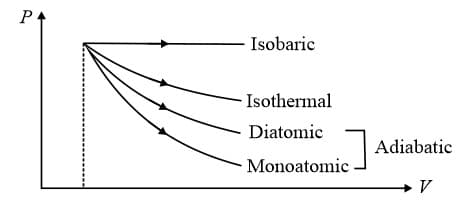The internal energy of an ideal gas decreases by the same amount as the work done by the system.

Important Points to Remember in Chapter -1 - Laws of Thermodynamics from H C Verma CONCEPTS OF PHYSICS [VOLUME 2] Solutions
1. Thermodynamics:
Study of energy changes between system & surrounding is called thermodynamics. There are three types of systems open, closed & isolated.
2. Zeroth Law of Thermodynamics:
If two systems are each in thermal equilibrium with a third, they are also in thermal equilibrium with each other.
3. First Law of Thermodynamics:
Heat supplied to a system is equal to algebraic sum of change in internal energy of the system and mechanical work done by the system.
(i)
(ii) Sign Convention:
(a) Heat absorbed by the system positive.
(b) Heat rejected by the system negative.
(c) Increase in internal energy (i.e. rise in temperature) positive.
(d) Decrease in internal energy (i.e. fall in temperature) negative.
(e) Work done by the system positive.
(f) Work done on the system negative.
(iii) For isochoric process:
(a) In this process, constant
(b)
(c)
(d)
(iv) For isobaric process:
(a) In this process, constant
(b)
(c)
(d)
(e)
(v) For adiabatic process:
(a) In this process,
(b) constant
(c) constant
(d) constant
(e)
(vi) For isothermal process:
(a) In this process, constant or
(b) constant
(c)
(d)
(vii) For any general polytropic process:
(a) constant
(b) Molar heat capacity,
(c) Work done by gas,
(d) Slope of diagram (also known as indicator diagram) at any point is
(viii) For cyclic process,
(a)
(b)

4. Second Law of Thermodynamics:
(i) Kelvin- Planck Statement:
It is impossible to construct an engine, operating in a cycle, which will produce no effect other than extracting heat from a reservoir and performing an equivalent amount of work.
(ii) Rudlope Classius Statement:
It is impossible to make heat flow from a body at a lower temperature to a body at a higher temperature without doing external work on the working substance.
5. Heat Engines and Refrigerators:
(i) Carnot Engine: It is a hypothetical engine with maximum possible efficiency.
Process are isothermal.
Process are adiabatic.

(ii) Efficiency of a cycle:
(a) For Carnot cycle:
(b) For refrigerator:
Coefficient of performance,
6. Bulk modulus of gases:
(i)
(ii) Isothermal bulk modulus of elasticity,
(iii) Adiabatic bulk modulus of elasticity,
7. Thermodynamic Processes and Indicator Diagrams:
(i) Work done is least for monoatomic gas (adiabatic process)

(ii) Air quickly leaking out of a balloon becomes cooler as the leaking air undergoes adiabatic expansion.
(iii) First law of thermodynamics does not forbid flow of heat from lower temperature to higher temperature.
(iv) First law of thermodynamics allows many processes which actually don't happen.


